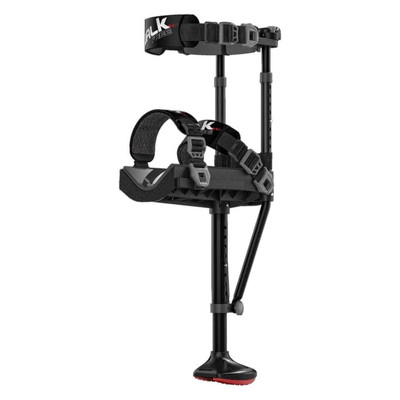Description
**This product has now been superceded by the iWALK 3.0 - Available Here**
iWalk 2.0 is a carefully engineered multiple award winning medical mobility device that ends the pain and inconvenience of conventional crutches. Easy to learn, easy to use, crutches and knee scooters are now
Standard crutches hurt!
Crutches hurt and are hard to walk in. Navigating stairs on crutches is dangerous. Underarms get bruised and rubbed raw. Crutches make your arms and shoulders fatigue. Traditional underarm crutches can be painful, especially if they are not fitted correctly. There are many nerve endings in the armpit, and they get irritated and sore, sometimes even causing shoulder and neck pain.
If you are using crutches for an extended period of time and you are mobile on them quite a bit, your wrists will ache and you can even end up with a serious condition like carpal tunnel. The pads help when exploring how to make crutches more comfortable, but won’t prevent sore hands from crutches.

iWALK 2.0 Benefits
Everyday activities are impossible on traditional crutches or knee scooters. With iWALK2.0 you can immediately get back to your routine. So whether you’re pushing a shopping cart, going up or down stairs, carrying a cup of coffee, or walking the dog, the iWALK2.0 gives you your life back.
Frequently Asked Question:
Can I Use the iWALK2.0
If you’re like most people, the answer is YES! iWALK2.0 is simple – it recruits the upper leg for stability and balance, so iWALKing is easy and intuitive. In short, if you can walk, then you can iWALK.
Before your injury, could you walk unassisted? Could you go up and down stairs without requiring the handrail for balance or support? If yes, then you are totally capable of using the iWALK2.0.
You CAN use iWALK2.0 if:
Compliance
-
You commit to following our instructions for Fitting and Use BEFORE your first use
-
You’re willing to spend at least 5-20 minutes to let your body learn and adapt to using the iWALK2.0
Pre-injury Ability
-
You have average strength and balance
-
Pre-injury, you could walk normally without a limp, shuffle, etc.
-
Pre-injury, you could go up or down stairs without requiring a handrail for balance or support.
Capacity
-
You are between 147cm and 198cm see chart for specific leg length limits.
-
You weigh 125kg or less.
-
Maximum thigh circumference (at top of leg) is 28” (71cm) or less.
Other Requirements
-
Your injury is to one leg only.
-
Your injury is below the knee.
-
You can bend your injured leg 90 degrees at the knee (casts and boots are OK)
-
You have full functionality in your uninjured leg.
You CANNOT use iWALK2.0 if:
Compliance
-
You plan on trying the iWALK2.0 on your own, without following our FITTING and USE instructions first. HINT – we’ve made it easy for you – so follow our instructions and don’t go it alone.
Pre-injury Ability
-
You’re challenged by normal activities like walking, climbing stairs, etc.
-
You cannot walk without an assistive device
-
You lose your balance
-
You must use the handrail to go up or down stairs
-
You don’t have full use of your uninjured leg
Capacity
-
You weigh over 275 pounds (125 kg) or are significantly overweight.
-
Your upper thigh circumference (at the top of your leg) is more than 28” (71cm).
Other Requirements
-
You cannot bend your injured leg 90 degrees at the knee.
iWALK2.0 works for these common lower leg injuries
Foot fracture, sprained ankle, broken ankle, Achilles tendon rupture, Achilles tendon injuries, bunions, tiba fracture, fibula fracture, Jones fracture, plantar fasciitis, stress fractures (lower leg), below knee amputation, foot and ankle dislocations, foot ulcers, calf muscle tear, calf muscle strain, gastrocnemius tear, almost any lower leg injury is indicated for use with iWALK2.0.
iWALK2.0 does NOT work for these leg injuries
Any injury to the knee or above. So common conditions like ACL tears, MCL tears, patella conditions, other knee injuries, hamstring tears and strains, groin injuries, piriformis injuries, IT band issues, illiopsoas (hip flexor) conditions, diabetic ulcers where proprioception issues adversely affect balance or any other knee or above upper leg injury.
HEIGHT ADJUSTMENT
Push button spring adjustment works similar to standard crutches. Allows you to tailor to the length of your upper leg and lower leg independently. Always adjust the upper leg length as high as possible so that Thigh Supports are at the very top of your leg.
Upper leg adjustment range: 12.0” – 18.0”
Lower leg adjustment range: 13.75″ – 20″
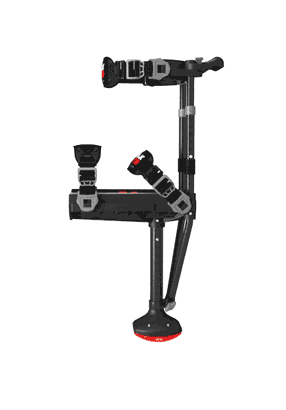
THIGH SUPPORT
The Thigh Supports recruit the upper leg to align and stabilize the crutch. Adjusts for thigh circumference from 15.5” to 28.0”. Left and Right are independently adjustable.
Are you Valgus (knock kneed) or Varus (bow legged)? Most of us are one or the other to some degree. Asymmetrical adjustment of the Thigh Supports compensates for both conditions – see Fitting and Use for more information.
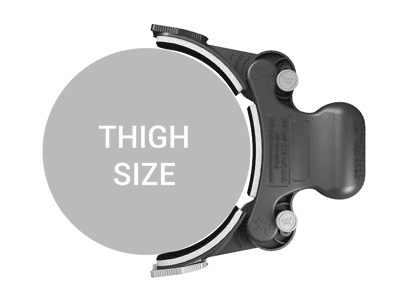
CALF STRAP SLIDER MOUNT
The Calf Strap Mounts are on rails that run along the length of the Knee Platform. They can be repositioned by hand along the length of the rails to allow you to position the Calf Strap forward or back on the Knee Platform. You use this in cases where the standard Strap position (at the back of the Knee Platform) might irritate your injury. Below knee amputees will typically position the strap further forward to accommodate their residual limb.
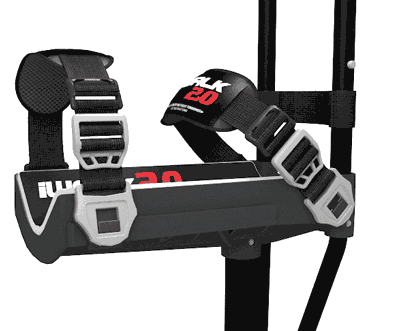
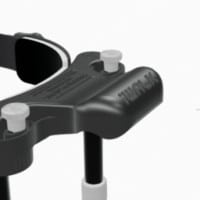
1. HANDLE
Gives user confidence and aids in initial learning. Often used for longer distances to improve efficiency. Used for short distances to keep crutch aligned and in contact with the user’s leg when walking without straps. Also used when treating the crutch like a cane for assisting in getting up from seated position.
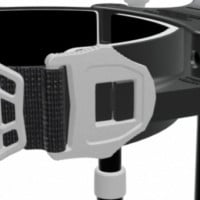
2. QUICK RELEASE BUCKLES
Quick release buckles allow you to quickly put on or take off the crutch. After basic proficiency is achieved, most people can don / doff the crutch in 10-15 seconds. As an additional safety feature, straps must be loosened fully before buckle can disengage. Converts tool-free for Left or Right leg use.
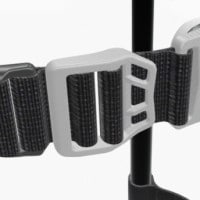
3. STRAP – TIGHTEN / LOOSEN SECTION (ON/OFF)
Proper tensioning of the strap is essential to give you maximum control and safety. This section, denoted by the Gray buckles, is ergonomically positioned on the outside of your leg, allows you to fully and significantly tension the strap with a quick pull on the end of the strap. A quick lift of the buckle releases tension so you can quickly take the crutch off.
Description
**This product has now been superceded by the iWALK 3.0 - Available Here**
iWalk 2.0 is a carefully engineered multiple award winning medical mobility device that ends the pain and inconvenience of conventional crutches. Easy to learn, easy to use, crutches and knee scooters are now
Standard crutches hurt!
Crutches hurt and are hard to walk in. Navigating stairs on crutches is dangerous. Underarms get bruised and rubbed raw. Crutches make your arms and shoulders fatigue. Traditional underarm crutches can be painful, especially if they are not fitted correctly. There are many nerve endings in the armpit, and they get irritated and sore, sometimes even causing shoulder and neck pain.
If you are using crutches for an extended period of time and you are mobile on them quite a bit, your wrists will ache and you can even end up with a serious condition like carpal tunnel. The pads help when exploring how to make crutches more comfortable, but won’t prevent sore hands from crutches.

iWALK 2.0 Benefits
Everyday activities are impossible on traditional crutches or knee scooters. With iWALK2.0 you can immediately get back to your routine. So whether you’re pushing a shopping cart, going up or down stairs, carrying a cup of coffee, or walking the dog, the iWALK2.0 gives you your life back.
Frequently Asked Question:
Can I Use the iWALK2.0
If you’re like most people, the answer is YES! iWALK2.0 is simple – it recruits the upper leg for stability and balance, so iWALKing is easy and intuitive. In short, if you can walk, then you can iWALK.
Before your injury, could you walk unassisted? Could you go up and down stairs without requiring the handrail for balance or support? If yes, then you are totally capable of using the iWALK2.0.
You CAN use iWALK2.0 if:
Compliance
-
You commit to following our instructions for Fitting and Use BEFORE your first use
-
You’re willing to spend at least 5-20 minutes to let your body learn and adapt to using the iWALK2.0
Pre-injury Ability
-
You have average strength and balance
-
Pre-injury, you could walk normally without a limp, shuffle, etc.
-
Pre-injury, you could go up or down stairs without requiring a handrail for balance or support.
Capacity
-
You are between 147cm and 198cm see chart for specific leg length limits.
-
You weigh 125kg or less.
-
Maximum thigh circumference (at top of leg) is 28” (71cm) or less.
Other Requirements
-
Your injury is to one leg only.
-
Your injury is below the knee.
-
You can bend your injured leg 90 degrees at the knee (casts and boots are OK)
-
You have full functionality in your uninjured leg.
You CANNOT use iWALK2.0 if:
Compliance
-
You plan on trying the iWALK2.0 on your own, without following our FITTING and USE instructions first. HINT – we’ve made it easy for you – so follow our instructions and don’t go it alone.
Pre-injury Ability
-
You’re challenged by normal activities like walking, climbing stairs, etc.
-
You cannot walk without an assistive device
-
You lose your balance
-
You must use the handrail to go up or down stairs
-
You don’t have full use of your uninjured leg
Capacity
-
You weigh over 275 pounds (125 kg) or are significantly overweight.
-
Your upper thigh circumference (at the top of your leg) is more than 28” (71cm).
Other Requirements
-
You cannot bend your injured leg 90 degrees at the knee.
iWALK2.0 works for these common lower leg injuries
Foot fracture, sprained ankle, broken ankle, Achilles tendon rupture, Achilles tendon injuries, bunions, tiba fracture, fibula fracture, Jones fracture, plantar fasciitis, stress fractures (lower leg), below knee amputation, foot and ankle dislocations, foot ulcers, calf muscle tear, calf muscle strain, gastrocnemius tear, almost any lower leg injury is indicated for use with iWALK2.0.
iWALK2.0 does NOT work for these leg injuries
Any injury to the knee or above. So common conditions like ACL tears, MCL tears, patella conditions, other knee injuries, hamstring tears and strains, groin injuries, piriformis injuries, IT band issues, illiopsoas (hip flexor) conditions, diabetic ulcers where proprioception issues adversely affect balance or any other knee or above upper leg injury.
HEIGHT ADJUSTMENT
Push button spring adjustment works similar to standard crutches. Allows you to tailor to the length of your upper leg and lower leg independently. Always adjust the upper leg length as high as possible so that Thigh Supports are at the very top of your leg.
Upper leg adjustment range: 12.0” – 18.0”
Lower leg adjustment range: 13.75″ – 20″

THIGH SUPPORT
The Thigh Supports recruit the upper leg to align and stabilize the crutch. Adjusts for thigh circumference from 15.5” to 28.0”. Left and Right are independently adjustable.
Are you Valgus (knock kneed) or Varus (bow legged)? Most of us are one or the other to some degree. Asymmetrical adjustment of the Thigh Supports compensates for both conditions – see Fitting and Use for more information.

CALF STRAP SLIDER MOUNT
The Calf Strap Mounts are on rails that run along the length of the Knee Platform. They can be repositioned by hand along the length of the rails to allow you to position the Calf Strap forward or back on the Knee Platform. You use this in cases where the standard Strap position (at the back of the Knee Platform) might irritate your injury. Below knee amputees will typically position the strap further forward to accommodate their residual limb.


1. HANDLE
Gives user confidence and aids in initial learning. Often used for longer distances to improve efficiency. Used for short distances to keep crutch aligned and in contact with the user’s leg when walking without straps. Also used when treating the crutch like a cane for assisting in getting up from seated position.

2. QUICK RELEASE BUCKLES
Quick release buckles allow you to quickly put on or take off the crutch. After basic proficiency is achieved, most people can don / doff the crutch in 10-15 seconds. As an additional safety feature, straps must be loosened fully before buckle can disengage. Converts tool-free for Left or Right leg use.

3. STRAP – TIGHTEN / LOOSEN SECTION (ON/OFF)
Proper tensioning of the strap is essential to give you maximum control and safety. This section, denoted by the Gray buckles, is ergonomically positioned on the outside of your leg, allows you to fully and significantly tension the strap with a quick pull on the end of the strap. A quick lift of the buckle releases tension so you can quickly take the crutch off.

